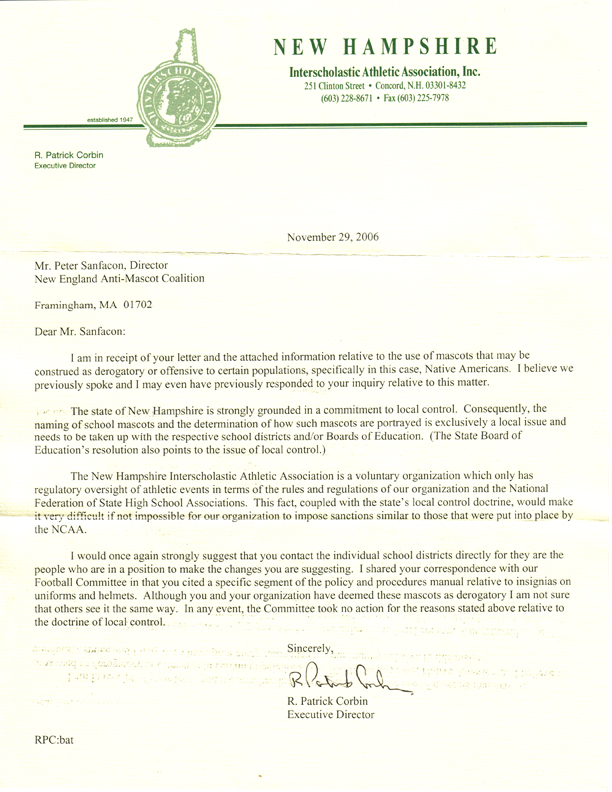

In a letter received at the New England Anti-Mascot Coalition on 12/9/06, R. Patrick Corbin, executive director of the New Hampshire Interscholastic Athletic Association, announced that his organization has decided to take "no action" on the matter of NHIAA member schools' continued use of "Indian" nicknames and symbols citing New Hampshire's "doctrine of local control."
Corbin's letter was in response to an NEAMC letter sent to NHIAA's Concord, N.H., headquarters in late November.
The contents of our letter follows.
November 22, 2006
R. Patrick Corbin
Executive Director
New Hampshire Interscholastic Athletic Association
251 Clinton Street
Concord, NH 03301
Dear Mr. Corbin,
My name is Pete Sanfaçon and I am the founder and director of the New England Anti-Mascot Coalition, a grassroots organization made up of Indian and non-Indian advocates whose purpose is to address the widespread and decades-long use of Indian people and their culture as nicknames and logos for high school sports teams throughout New England. In the northeast there are dozens of high schools using names like “Indians,” “Warriors,” or “Red Raiders,” 6 of which are in New Hampshire.
I am writing to you today in hopes of starting a dialogue on this issue. Currently, there are six NHIAA member schools whose sports teams use “Indian” nicknames or logos: Belmont (Red Raiders), Laconia (Sachems), Merrimack (Tomahawks), Sanborn Regional in Kingston (Indians), Winnacunnet in Hampton (Warriors), and Spaulding in Rochester (Red Raiders). Representatives of three of these schools are members of the NHIAA Football Committee. I was born and raised in Rochester and graduated from Spaulding High School in 1977.
According to the N.H. Department of Education, during the 2005-2006 school year there were 27 students enrolled in Rochester schools identified as “American Indian or Alaskan Native.” That accounts for just 0.6% of the total enrollment of 4,796 students. Of that grand total, 4,550 students were identified as “White, Non-Hispanic.” That’s 94.9% of the total student enrollment in Rochester schools. In 2005-2006 the Rochester School District had the 6th highest enrollment in the state, behind only Manchester, Nashua, Londonderry, Concord, and Salem.
The school districts for the other five high schools in N.H. using “Indian” nicknames and logos have similar enrollment numbers.
In the state of New Hampshire last year there were a total of 645 American Indian/Alaskan Native students enrolled in public schools (including “Public Academies, Joint Maintenance Agreement, and Charter Schools”). That’s just 0.3% of the total enrollment of 205,767 students statewide. The question is what are we teaching the other 99.7% of students about real, living Native people? It is not unreasonable to presume that at the six high schools currently using “Indian” nicknames or logos there may be precious little education on this subject at all.
You may be aware of the action taken by the NCAA in August 2005 regarding colleges and universities who use similar nicknames, logos, and mascots being barred from hosting NCAA tournaments. I’ve enclosed some literature from the NCAA that I hope you find informative. We at the NEAMC urge you to consider taking similar action against high schools in the state of New Hampshire.
In the NHIAA’s 2006 “POLICIES AND PROCEDURES MANUAL FOR THE CONDUCT OF FOOTBALL” there is a documented stipulation with respect to “Decals and Logos on Helmets” (pg. 8), which states “Decals or logos that are of a commercial nature or support the use of alcohol, drugs or tobacco products; are sexually explicit or implicit; are derogatory or obscene ARE NOT permitted” (underlined emphasis added). We feel quite strongly that the depiction of racial stereotypes on helmets and uniforms is “derogatory.” We feel that referring to Native people as “Raiders” and “Warriors” or using the terms “Tomahawks,” “Sachems,” or “Indians” in connection to sports activities at educational institutions is disrespectful and offensive. Regardless of the so-called traditions in place at these schools, in this day and age, isn’t it time to do the right thing?
It is our hope that by providing education to communities across New England, we can finally bring an end to an outdated practice and encourage school districts and athletic organizations to start new traditions that embrace diversity and inspire students to become exemplary citizens and leaders within their community.
Sincerely,
Pete Sanfaçon
Director
New England Anti-Mascot Coalition
(This letter contained numerous attachments, including the 2002 N.H. State Board of Education Resolution, resolutions by the NAACP, U.S. Commission on Civil Rights, National Congress of American Indians, Intertribal Council of the Five Civilized Tribes, select essays on the topic, and a selection of materials regarding the NCAA's 2005 decision to ban certain teams from NCAA tournaments.)
